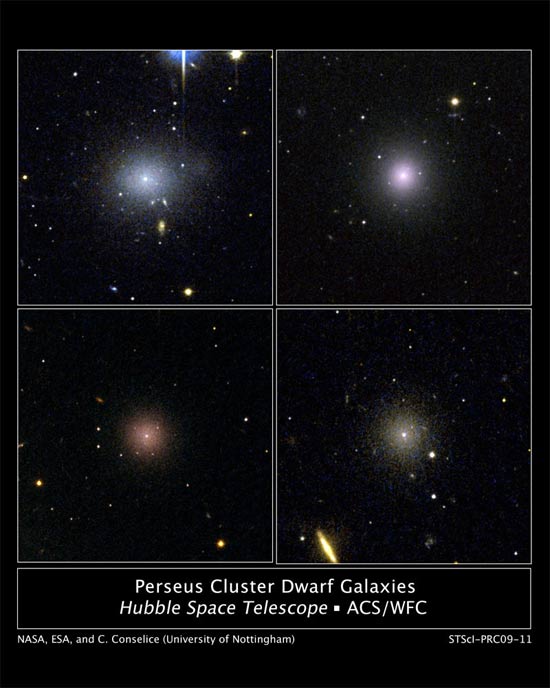Galaxies Protected by Dark Matter

NASA's Hubble Space Telescope has uncovered new evidence that galaxies are embedded in and protected by halos of dark matter, the invisible form of matter that accounts for most of the universe's mass.
Dark matter is invisible and nobody even knows what it is, but it is evident by the fact that galaxies hold together at all. Some unseen substance lurks in space — concentrated in galaxies — and generated gravity in amounts well beyond the visible matter.
Peering into the tumultuous heart of the nearby Perseus galaxy cluster (located 250 million light-years away), Hubble discovered a large population of small galaxies that have remained intact while larger galaxies around them are being ripped apart by the gravitational pull of neighboring galaxies.
"We were surprised to find so many dwarf galaxies in the core of this cluster that were so smooth and round and had no evidence at all of any kind of disturbance," said astronomer Christopher Conselice of the University of Nottingham in England, and leader of the Hubble observations. "These dwarfs are very old galaxies that have been in the cluster a long time. So if something was going to disrupt them, it would have happened by now. They must be very, very dark matter-dominated galaxies."
The dwarf galaxies may have even higher amounts of dark matter than spiral galaxies like our Milky Way.
"With these results, we cannot say whether the dark-matter content of the dwarfs is higher than in the Milky Way Galaxy," Conselice said. "Although, the fact that spiral galaxies are destroyed in clusters, while the dwarfs are not, suggests that is indeed the case."
The results of the observations are detailed in the March 1 edition of the journal Monthly Notices of the Royal Astronomical Society.
Get the Space.com Newsletter
Breaking space news, the latest updates on rocket launches, skywatching events and more!
First proposed about 80 years ago, dark matter is thought to be the "glue" that holds galaxies together. Astronomers suggest that dark matter provides vital "scaffolding" for the universe, forming a framework for the formation of galaxies through gravitational attraction.
Previous studies with Hubble and NASA's Chandra X-ray Observatory found evidence of dark matter in entire clusters of galaxies such as the Bullet Cluster. The new Hubble observations continue the search for dark matter in individual galaxies.
Because dark matter cannot be seen, astronomers detect its presence through indirect evidence. The most common method is by measuring the velocities of individual stars or groups of stars as they move randomly in the galaxy or as they rotate around the galaxy. But the Perseus Cluster is too far away for telescopes to resolve individual stars and measure their motions.
Instead, Conselice and his team derived a new technique for uncovering dark matter in these dwarf galaxies by determining the minimum mass the dwarfs must have to protect them from being disrupted by the strong tidal pull of gravity from larger galaxies.
Join our Space Forums to keep talking space on the latest missions, night sky and more! And if you have a news tip, correction or comment, let us know at: community@space.com.

Space.com is the premier source of space exploration, innovation and astronomy news, chronicling (and celebrating) humanity's ongoing expansion across the final frontier. Originally founded in 1999, Space.com is, and always has been, the passion of writers and editors who are space fans and also trained journalists. Our current news team consists of Editor-in-Chief Tariq Malik; Editor Hanneke Weitering, Senior Space Writer Mike Wall; Senior Writer Meghan Bartels; Senior Writer Chelsea Gohd, Senior Writer Tereza Pultarova and Staff Writer Alexander Cox, focusing on e-commerce. Senior Producer Steve Spaleta oversees our space videos, with Diana Whitcroft as our Social Media Editor.









